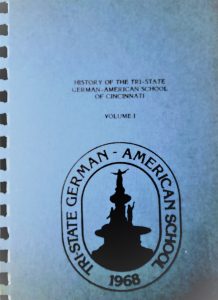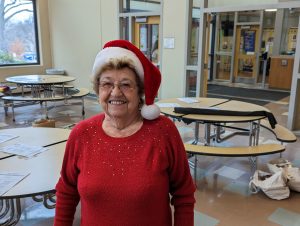A fine, professional faculty and many dedicated, supportive individuals contribute to our continued growth and success. It is a source of satisfaction and pride for all of us to know that our students feel they are not only exposed to excellent language study, but to the best German-American culture and friendship. This is our aim, and we will go on in this spirit.
Auguste G. Kent
Principal, Tri-State German-American School of Cincinnati 1986
Headnote: Much of the context of this page has been summarized and/or paraphrased, but nonetheless has been explicitly derived from the "History of the Tri-State German-American School of Cincinnati, Ohio Volume I", handbook printed in the spring of 1986 and prefaced by Auguste G. Kent, then-Principal, Tri-State German-American School of Cincinnati. All information is believed to be accurate based upon researched written and verbal accounts of the school's history.

Founding and Early Years
Years of preparatory work culminated in the founding of the Tri-State German-American School Society. From 1958 to 1961, an evening school sponsored by the Donauschwaben Society existed in Cincinnati for the children of German immigrants to formally learn to read and write in their family's mother tongue. About 60 children were enrolled each year.
After this institution was no longer in existence following a sabbatical leave from teacher, Dr. Anne K. Gruenbauer, another partially successful endeavor in German instruction was undertaken in rooms provided by Old St. Mary's Church in downtown Cincinnati. However, it became evident that a supporting organization would be necessary to make such an endeavor a full success.
After obtaining assistance from the Consulate of the Federal Republic of Germany (then in Cleveland) and University of Cincinnati Professor, Dr. Gottfried Merkel, addresses for other then-existing German-American school societies across the country were obtained.
Lively correspondence with these organizations ensued and a questionnaire about the feasibility of starting such a school society in Cincinnati was published in early 1968. As a probable payoff to Cincinnati's heavy German immigration numbers and deep heritage, the response surpassed all expectations, and enough information was collected and evaluated to have multiple meetings purposed to set up the structure, location, board election, teacher selection, and other facets of the organization.
On November 7th, 1968, nine U.S. citizens residing in Cincinnati signed two documents, the Articles of Incorporation and the Code of Regulations, formally founding the Tri-State German-American School Society of Cincinnati, Ohio. The said corporation was organized for the promotion of the German language together with German culture. These initial nine founders and Trustees of the Corporation were:
- W.A. Kraeling, M.D. - President
-
Mrs. Maria Westendorf - Vice President
-
Kurt Seybold - Treasurer
-
Mrs. Helga Bucher - Recording Secretary
-
Erwin Bauder - Corresponding Secretary
-
Anton Ertel - Principal
-
Henry Langer
-
Peter Lind
-
Walter Gumpert

The first day of classes was only two days after the school's founding, on Saturday, November 9th of 1968. One hundred and ten children appeared, and five classes were formed. The official enrollment as of November 30th was 160 children and 80 memberships.
Upon the school's official opening celebration on January 25, 1969, dignitaries including local and state political officials, college / university / public school representatives, local press and media personnel, clergy, and German Consul and Ambassadorship roles were invited. Following the entertainment, the event culminated with an address by the German Consul, Irene Meyer, who had visited from Cleveland.
The school's first location was at the Concordia Lutheran School and classes were held on Saturdays from noon until 3pm.
The school was founded with the mantra of providing quality instruction at a low cost, yielding the tuition structure that continues to the current era - a single family membership fee coupled by class tuition charges that are reduced when more than one student attends classes. Several organizations, local and international alike, have lent substantial financial and other support over the years to help the school sustain its low tuition model.
Many initial challenges were overcome during these early years, such as finding and maintaining a qualified teaching staff who could hold the interest of the youngsters for three hours on a Saturday, proper textbooks for students of varied skill levels, and other considerations.
1970s - 1990s
In the 1975-1976 period, the school moved to a new location - the Doherty School in Walnut Hills. It was one of the Seven Hills Schools, which was better suited for children because of improved facilities, beautiful grounds with plenty of free parking, more storage space for educational materials, and even a caretaker.
By 1976-1977, the level of adult learners was nearing that of the children, and a more refined structure of beginner, intermediate, and advanced levels was notably taking place. Although it was a policy adhered to from inception of the school, it was also during this timeframe that the non-discriminatory policy was resolved as a statement, a cornerstone tenet of the school of which it proudly and prominently displays on published literature and signage.
In 1978, the school received tax-exempt status, meaning among other things, that any contributions given to the school would now be tax-deductible.
In the early 1980s and by the third year of new principal, Auguste Kent, who was appointed in 1979, the school had grown to 161 students - 76 children and 85 adults.
New classes were added during this era, including those at an advanced level, geared toward engaging native and near-fluent speakers.
During the 1990s, TSGAS moved to a new home at St. Ursula Academy in Walnut Hills OH.
Many enjoyable opportunities for students and staff to routinely take part in external activities arose, such as the downtown and Germania Society Oktoberfests and Chriskindlmarkts, German Days of the Buergerliga, helping at the WCET-Channel 48's Action Auction, and various other civic events and programs.
2000s forward
Near the onset of the new millennium, the school officially moved its physical presence to the spacious Notre Dame Academy in Park Hills, KY where adequate classrooms were rented for children, teenage, and adult instruction. Students, and often even entire families from the Greater Cincinnati, Northern Kentucky, and Southeast Indiana area (the 'Tri-State') were able to transit to this convenient, central location for many years.
The school's 50th year anniversary was notably celebrated in 2018 with a large presentation on the NDA school grounds. Entertainment and many prominent speakers graced the event.
In 2020, at the onset of the Covid-19 pandemic, the school administration reacted at an incredible pace in keeping the school population safe, yet still engaged via remote learning capability for the first time ever. This resiliency and ability to rapidly adapt to unexpected circumstances and embrace new technical landscapes once again demonstrated the tenacity and dedication of the TSGAS students and staff.
Concurrent with the decision to return to in-person classes in the fall of 2022, the board located a fantastic new home at the Fairview Clifton German Language School. Fairview Clifton is also in a central location, and the cultural connection between TSGAS and this acclaimed Cincinnati Public School (CPS) magnet school opens exciting opportunities to collaborate in ways expected to benefit both organizations.
Classes currently exist for all age and experience levels on Saturday mornings from 10am - 12:30pm with a break ('die Pause') in between sessions for good conversation and refreshments. With the experience of successfully conducting remote classes gained during the Covid19 restrictions, several evening and online classes are also now being offered as a method of expanded flexibility to the school's student population.
In the famed TSGAS casual, low-pressure, but highly supportive learning environment, students are able to select the class level and instructor they feel comfortable with and hence, can progress at their own pace. There continues to be a mix of native speaking instructors along with other highly qualified educators who lead enjoyable, engaging learning sessions each week throughout the school year.
Der Brunnen (The Fountain), the school's current newsletter, is published periodically and besides being downloadable from this website, is available for electronic mailing to current and prospective school membership. It contains current school information, contacts, German prose, recipes, and various other tidbits of useful information.
As with years past, the students and staff continue to have a variety of volunteer and participatory activities related to the school and German events within the Tri-State. From the previously mentioned traditional events to newer activities such as Bock Fest, Cincinnati's German heritage is prominent and active year-round, where you can almost certainly count on TSGAS members to be present and in the spotlight.
Far more than able to mention in the brevity of this webpage are so many incredibly dedicated, talented, and resourceful instructors, administrators, supporters, and students who have been involved with the resounding success of TSGAS over the decades. The board members, administration, and faculty have changed numerous times; and of course, students have cycled through their language learning journeys over the decades. Right up through today, others continue taking up the torch and working diligently to keep the German language and culture alive and flourishing in the Tri-State. In the same spirit reinforcing the highlighted quote at the top of this page by Auguste G. Kent way back in 1986, all indications point to TSGAS indeed continuing to have a bright future.
